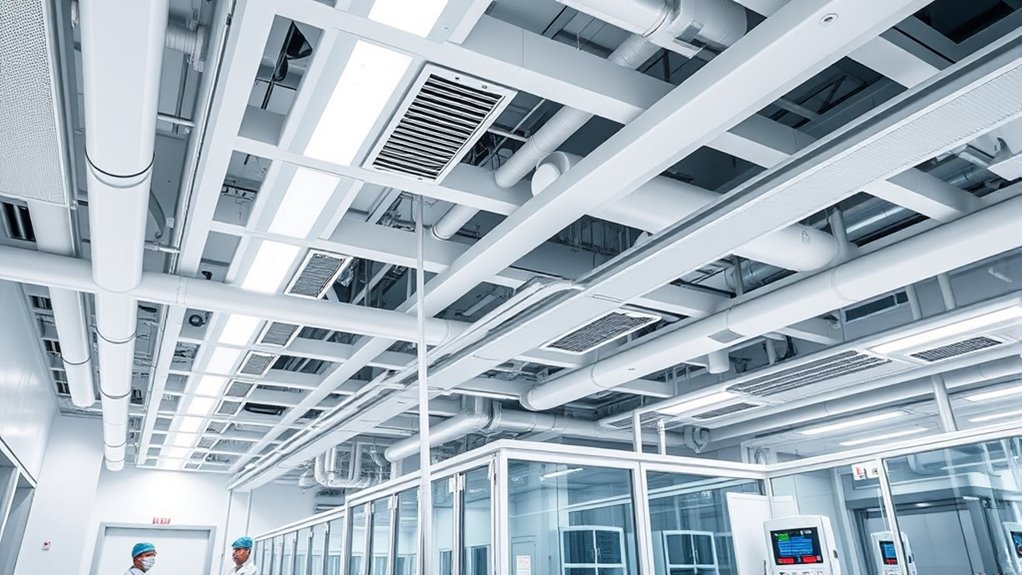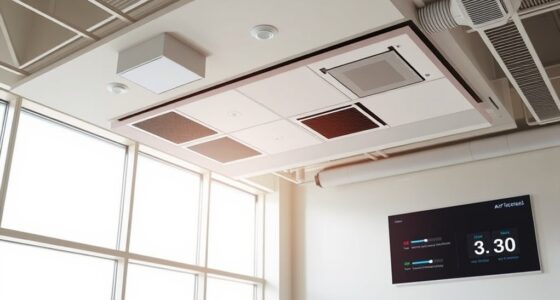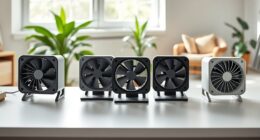When choosing HVAC systems for healthcare facilities, emphasize ones with robust air filtration, like HEPA filters, to prevent infection spread. Look for energy-efficient models that adapt to demand, reducing operational costs. Guarantee the system allows precise control for different zones, especially in sensitive areas. Regular maintenance and compliance with health standards are essential for safety and longevity. Continuing with this guide will help you select the most effective, compliant HVAC options for your facility.
Key Takeaways
- Prioritize systems with robust air filtration, such as HEPA filters, to ensure airborne pathogen removal and compliance with health standards.
- Choose energy-efficient HVAC units with smart controls and variable speed motors to reduce operational costs and environmental impact.
- Implement zoning and proper ventilation rates to allow precise control of airflow and temperature in different healthcare areas.
- Ensure regular maintenance access and durable components to sustain system performance and indoor air quality over time.
- Consult healthcare HVAC specialists to select systems meeting regulatory standards and tailored to facility-specific needs.

Choosing the right HVAC system for healthcare facilities is critical to ensuring a safe and comfortable environment for patients, staff, and visitors. In healthcare settings, air quality isn’t just about comfort—it’s a matter of safety. Effective air filtration becomes your first line of defense against airborne pathogens, dust, and pollutants. You need systems that can handle high-efficiency particulate air (HEPA) filters or other advanced filtration methods to remove bacteria, viruses, and particulates from the air. This level of filtration helps prevent the spread of infections, especially in sensitive areas like operating rooms and patient wards. When selecting HVAC systems, prioritize units that integrate robust air filtration capabilities to meet stringent health standards.
Energy efficiency also plays a essential role in your decision-making process. Healthcare facilities operate around the clock, consuming significant energy for heating, cooling, and air circulation. Choosing energy-efficient systems helps reduce operational costs and minimizes environmental impact. Modern HVAC units equipped with variable speed motors, smart controls, and high-efficiency components can adapt to fluctuating demands, ensuring ideal performance without wasting energy. Additionally, look for systems that support demand-controlled ventilation, which adjusts airflow based on occupancy levels, further conserving energy. Achieving this balance between air quality and energy consumption not only ensures regulatory compliance but also supports sustainability goals.
When evaluating HVAC options, consider the design and configuration that best suit your facility’s layout. Zoning systems allow you to control air quality and temperature in different areas independently, ensuring targeted filtration and comfort where needed most. Proper ventilation rates are essential, especially in areas like isolation rooms or laboratories, where contaminated air must be swiftly removed. A system that offers precise control over airflow and filtration can help you maintain the strict indoor air quality standards required in healthcare environments. Incorporating ventilation standards ensures compliance with health and safety regulations while optimizing indoor air quality.
Furthermore, maintenance and system longevity are essential factors. Regular filter replacement, coil cleaning, and system checks ensure that your HVAC continues to operate efficiently and effectively. Investing in systems with easy access for maintenance minimizes downtime and prolongs lifespan. Lastly, consult with HVAC professionals experienced in healthcare settings—they can guide you to solutions that meet both your facility’s unique needs and regulatory requirements. By focusing on air filtration, energy efficiency, and thoughtful system design, you can select an HVAC setup that promotes safety, reduces costs, and supports a healing environment.
Frequently Asked Questions
How Often Should HVAC Systems Be Maintained in Healthcare Settings?
You should perform routine inspections on your healthcare facility’s HVAC systems at least every three to six months. During these inspections, replace filters regularly—typically every 1 to 3 months, depending on usage and filters type. Regular maintenance guarantees peak air quality and system efficiency. Don’t forget to check for any signs of wear or damage and address issues promptly to maintain a safe, healthy environment for patients and staff.
What Are the Latest Innovations in HVAC Technology for Hospitals?
Think of HVAC technology as a health guardian, constantly evolving. You’ll find smart sensors that actively monitor air quality and adjust systems in real-time, ensuring ideal conditions. UV sterilization is now integrated, using ultraviolet light to eliminate germs and viruses effectively. These innovations work like vigilant sentinels, creating safer environments in hospitals by improving air purity and reducing infection risks. Embrace these advancements to keep healthcare spaces healthier and safer.
How Do HVAC Systems Impact Infection Control in Healthcare Facilities?
Your HVAC systems substantially impact infection control by reducing airborne pathogens through effective air filtration. They help contain and eliminate airborne contaminants, minimizing the spread of infections within healthcare facilities. Properly designed systems ensure a steady flow of clean, filtered air, which protects patients and staff alike. By controlling airflow and filtering out pathogens, you create a safer environment, reducing the risk of healthcare-associated infections and promoting better overall health outcomes.
What Are the Energy Efficiency Considerations for Healthcare HVAC Systems?
Think of your healthcare HVAC system as the heart of your facility—its energy efficiency keeps everything beating smoothly. You should focus on energy-saving strategies like high-efficiency filters and variable-speed drives. Additionally, integrating renewable energy sources, such as solar panels, helps reduce costs and environmental impact. Regular maintenance and smart controls guarantee peak performance, making your system more sustainable and cost-effective, like a well-tuned instrument in perfect harmony.
Are There Specific HVAC Standards or Codes Unique to Healthcare Environments?
Yes, healthcare environments follow specific HVAC standards and codes, focusing on ventilation standards and air quality regulations. You must guarantee systems meet guidelines like ASHRAE 170 and CDC recommendations, which emphasize infection control, proper airflow, and filtration. By adhering to these requirements, you help maintain a safe, sterile environment vital for patient safety and staff well-being, reducing the risk of airborne contaminants and ensuring ideal indoor air quality.
Conclusion
Choosing the right HVAC system for healthcare facilities isn’t just important—it’s the difference between safeguarding lives or risking chaos. Your decision can prevent outbreaks, save countless lives, and guarantee flawless patient recovery. With the right system, you’re not just maintaining comfort; you’re creating an impenetrable fortress of health. Get it wrong, and you could release a storm of infections and chaos. So, pick wisely—because in healthcare, your HVAC choice can be nothing short of life or death.









